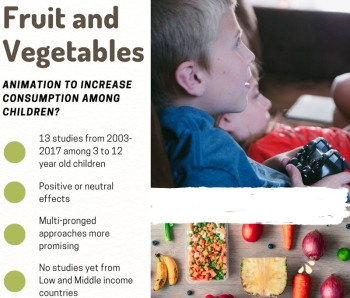Increasing fruit and vegetable consumption among children: a systematic review of animated nutrition interventions
Abstract
Background: Low consumption of fruits and vegetables among children can lead to deprivation of micronutrients necessary for growth and development and predispose them to NCDs later in life. Low consumption of these nutrient-rich foods is related to high consumption of nutrient-poor, high-energy foods, which leads to childhood overweight and obesity. Many children do not consume enough fruits and vegetables to meet recommendations. This review aims to assess the effectiveness of animated interventions in increasing children's fruit and vegetable consumption.
Methods: Articles on animated interventions for increasing fruit and vegetable consumption among children were systematically reviewed from Web of Science, PubMed, and Google Scholar. For the literature searches, inclusion and exclusion criteria were established, and the methodology followed the PRISMA recommendations. Extracted data were synthesized to show the effectiveness of interventions.
Results: Thirteen studies (2003-2017) of animated interventions targeting children (3-12 years) designed to increase their consumption of fruits and vegetables met the criteria for inclusion in the systematic review. Most of the studies (69.2%) were in the United States, with no studies in LMICs identified. The animation interventions used games (46.2%), characters (23.1%), adventures (23.1%), and comic books (7.7 %). 11 of the analysed studies revealed positive or neutral effects of interventions on fruit and vegetable consumption. Parental participation, goal setting, and rewards were identified as facilitators of success. Identified interventions were effective in the short term (follow-up <12months). The games and adventure interventions had the greatest effect, with multi-component interventions most effective in increasing fruit and vegetable intake.
Conclusion: There is a need for more research to determine the effectiveness of such interventions over extended periods. Multi-component interventions especially including parental involvement, goal setting, and rewards should be leveraged in designing similar interventions in LMICs since there was a conspicuous absence of such studies found in the literature.

Authors retain all copyrights. In making a submission to World Nutrition, they are certifying that all material is theirs except quotations, as indicated, and that they have obtained permission for any photos, tables, or graphics taken from other publications or websites.




